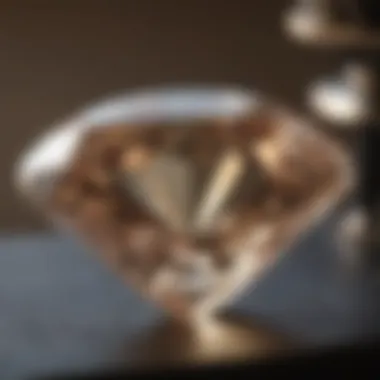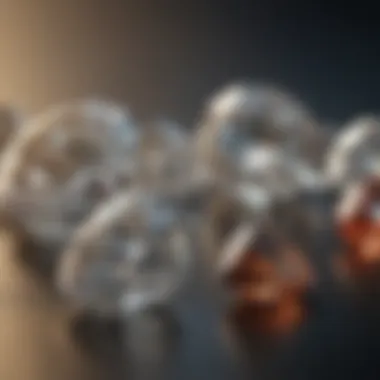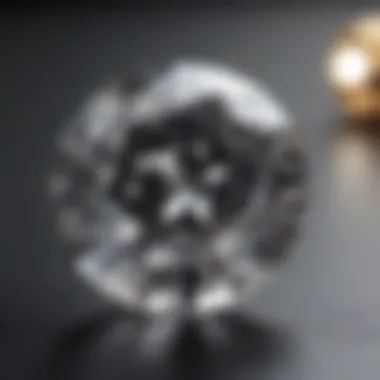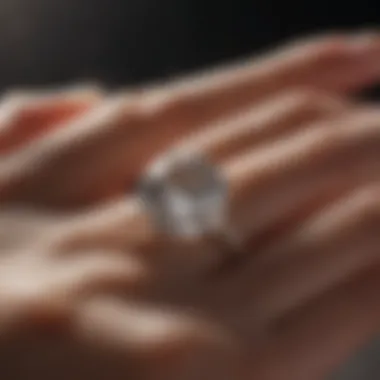Evaluating Carat Weight: Finding Your Perfect Diamond


Intro
Evaluating carat weight in diamonds is a complex undertaking. While many associate the size of a diamond with its quality, several factors contribute to the overall perception of value. This article aims to demystify the role of carat weight in diamond selection. It will also explore how budget, personal preference, and additional quality attributes such as cut, color, and clarity play significant roles in this process.
Gemstone Overview
Definition and Characteristics
Diamonds, a type of gemstone, are highly valued for their unique properties. Identified as a crystalline form of carbon, diamonds are renowned for their exceptional hardness and brilliance. When assessing diamonds, carat weight is one of the foremost attributes considered by buyers but does not singularly define the stone's worth.
Classification of Gemstones
Gemstones are classified based on several criteria, including their physical and chemical properties. In the context of diamonds, they fall under the category of precious stones, distinguished from semi-precious ones due to their rarity and market demand. The classification of diamonds often correlates with their carat weight, with larger stones typically fetching higher prices.
"The value of a diamond is not just defined by its size but by a combination of cut, clarity, color, and carat weight."
Historical Significance
Ancient Uses and Cultural Importance
Throughout history, diamonds have held significant cultural meaning. Ancient civilizations viewed diamonds as symbols of strength and invincibility. Their rarity and beauty made them desirable among royalty and nobility, paving the way for their association with wealth and status. In many cultures, diamonds were also believed to possess protective qualities, further enhancing their allure.
Myths and Legends Surrounding Gemstones
Many myths surround diamonds, often linking them to themes of love, protection, and spiritual power. In various legends, diamonds were often seen as talismans conferring invulnerability or enhancing personal vitality. These stories have shaped how diamonds are perceived in contemporary jewelry and engagement practices.
Understanding both the practical aspects of carat weight and the historical contexts enriches the buyer's journey. As we move forward, we will delve into what constitutes the ideal carat weight based on individual circumstances and preferences.
Understanding Diamond Carat Weight
Understanding diamond carat weight is a crucial part of evaluating any diamond. Carat weight primarily measures the weight of the diamond, which can directly affect its value and appeal. This section aims to clarify definitions, explore pricing implications, and differentiate between actual size and perceived size. A comprehensive grasp of these elements helps buyers and enthusiasts alike make informed choices, ensuring satisfaction with their selection.
Definition of Carat Weight
Carat weight serves as the standard measure for the weight of diamonds and other gemstones. One carat is equivalent to 200 milligrams. This unit of measurement is significant because it underlines the diamond's mass, which is a key determinant in establishing its value. As carat weight increases, so does the rarity, thus affecting demand and price.
How Carat Weight Affects Price
The impact of carat weight on the price of a diamond is pronounced. Generally, diamonds increase in price with weight due to scarcity. Larger stones are less commonly found, thus driving up costs. However, this does not imply a linear relationship. Sometimes, a diamond just above a particular carat threshold can experience a price jump. For example, a 1.99-carat diamond might cost significantly less than a 2.00-carat diamond, even though the differences in size may be negligible visually.
Carat Weight vs. Size Perception
Carat weight does not solely dictate the size of the diamond as perceived by the eye. Several factors influence how a diamond appears once set. The cut quality, shape, and setting style can enhance or detract from the stone’s apparent size. For example, a well-cut diamond may appear larger than its actual carat weight suggests, while a poorly cut diamond of the same weight may look smaller. Understanding these nuances is vital for buyers who wish to choose a diamond that meets their aesthetic expectations.
Factors Influencing Carat Choice
Understanding the factors influencing carat weight is crucial for anyone interested in purchasing a diamond. Beyond the numerical value of carat, these factors provide context to what makes a diamond suitable for the buyer's unique preferences and situation. Different elements, such as budget, lifestyle, and cultural significance, play a pivotal role in determining the ideal diamond size. Making an informed choice means carefully evaluating each of these aspects before finalizing a purchase.
Personal Budget Considerations
When it comes to selecting the right carat weight, personal budget is often the first factor to consider. Diamonds priced by carat weight can vary significantly. It's important to establish a clear budget from the outset. More carats usually mean a higher price. Thus, determining how much one is willing to invest is essential.
Many buyers rank their options based on compromised choices. For example, if a one-carat diamond is too expensive, a buyer might consider a 0.75-carat diamond of better cut quality. This can enhance appearance without stretching the budget too far. Other alternatives include exploring different shapes or settings that might visually amplify a smaller carat size. Conducting thorough research on price trends can also provide a more informed perspective on current market conditions for diamonds.


Lifestyle and Practicality
Lifestyle choices significantly affect the practicality of diamond carat weight. For example, someone with an active lifestyle may prefer a smaller diamond that is less susceptible to damage. In this case, a lower carat weight might be favored, focusing on durability over size. Conversely, individuals leading a more formal or less physically demanding life may opt for larger sizes that make a statement or symbolize status.
Moreover, the setting of the diamond plays a role in practical considerations. A protected setting, like a bezel, can accommodate a larger stone with less risk. There is also the consideration of how the ring fits into daily life. For example, someone who frequently engages in hands-on work may prioritize security and comfort over a dramatic looking size. In such cases, it is about finding balance between aesthetics and practicality.
Cultural Significance of Carat Size
Cultural values and symbolism can deeply impact expectations around carat size. In some cultures, larger diamonds carry greater significance. This can affect dating rituals or engagement traditions, where a substantial carat weight is seen as an expression of love and commitment. Conversely, in cultures where minimalism is prevalent, a smaller carat size might be regarded as more tasteful and appropriate.
The perception of carat size varies across different demographic groups as well. Younger consumers may be more influenced by trends that celebrate smaller, ethically sourced stones while others may aim for traditional and established symbols of wealth and status. Advertising and popular culture can also shape perceptions surrounding what constitutes an ideal carat size, making it vital for buyers to explore and understand these influences rather than simply relying on external expectations.
Evaluating Ideal Carat Sizes
Evaluating carat sizes is a critical aspect when considering a diamond purchase. Carat weight not only impacts the diamond's value but also influences its visual presentation. Understanding the ideal carat size allows individuals to make informed choices that align with their personal style and budget. This section delves into the prevalent carat sizes for engagement rings, factors affecting carat size selection, and comparative analysis of different carat weights to equip readers with comprehensive insights.
Standard Carat Sizes for Engagement Rings
Engagement rings commonly feature standard carat sizes that balance popularity with aesthetics. The most prevalent carat weights are typically 0.5, 1.0, and 1.5 carats. Each size has its unique appeal and positioning in the market.
- 0.5 Carat: Often chosen for those with budget constraints or for simpler styles. Its size can be delicate but still provides brilliant sparkle.
- 1.0 Carat: This is perhaps the most desired weight, representing a benchmark for many buyers. It is large enough to be eye-catching yet not overwhelmingly large.
- 1.5 Carats and Above: These sizes are favored by those seeking a more extravagant look. Sellers often notice that diamonds in this range command higher prices and attention.
Understanding these options helps buyers align their choices with both their aesthetic preferences and financial capabilities.
Factors Leading to a Good Carat Size
Shape Preferences
When selecting a diamond, shape plays a significant role in determining carat weight. The shape not only affects how the diamond looks but also influences how the weight appears on the finger. For instance, a round brilliant cut often appears larger than other shapes at the same carat weight due to its facets that reflect light more effectively. Meanwhile, fancy shapes like oval or pear may appear more elongated, giving a different impression of size. The shape preference can guide one’s decision on carat weight, particularly for those who appreciate a specific silhouette.
Setting Styles
The setting style affects the perceived size of the diamond. A halo setting, which surrounds the central stone with smaller diamonds, can create an illusion of a larger center stone. In contrast, a solitaire setting emphasizes the single diamond, focusing more on its actual carat weight. Different settings have various aesthetic qualities that can enhance or diminish the visual impact of the carat size.
- Pros of Halo Settings: They enhance the look of the main diamond and can make a smaller carat size appear larger.
- Cons of Solitaire Settings: They may emphasize a smaller carat weight, which can lead to dissatisfaction for some buyers.
Finger Size
A crucial aspect often overlooked is the buyer's finger size. A diamond might have the same carat weight but can look different based on the finger it is placed on. For example, on smaller fingers, even a one-carat diamond can appear larger than it would on a larger finger. Proportions matter, and buyers should consider how their diamond of choice will visually harmonize with their own hand size to ensure a pleasing aesthetic balance.
Comparative Analysis of Carat Sizes
A comparative analysis of carat sizes reveals how different weights influence overall perceptions. For example, while a two-carat diamond undoubtedly commands higher prices, it is essential to analyze whether the increased cost reflects a proportionate enhancement in appearance and brilliance.
Additionally, buyers should consider the emotional connection and long-term motivations behind their choice. Evaluating carat sizes not only broadens general knowledge but also allows for more strategic decision-making during the purchasing process.
By examining these various elements surrounding carat weight, individuals can effectively navigate their preferences, ensuring their choice resonates with both aesthetic goals and financial viability.
The Role of Cut, Color, and Clarity
The cut, color, and clarity of a diamond significantly influence its overall appearance and value. These attributes work together with carat weight to define the integrity and visual appeal of a diamond. Understanding how each of these three elements contributes to the perception of quality and beauty is essential for anyone considering a diamond purchase.
Impact of Cut Quality on Appearance
The cut of a diamond relates to how well it has been shaped and polished, affecting its brilliance and sparkle. A well-cut diamond reflects light in a way that enhances its visible qualities. If a diamond is cut too shallow or too deep, it may not achieve the optimal brilliance, causing it to appear lifeless or dull.


Key Factors of Cut Quality:
- Symmetry: Refers to how well the facets of the diamond align. Well-symmetrical diamonds encourage even light distribution.
- Proportions: The dimensions of the diamond, including depth and table size, affect how light interacts with the stone, maximizing or diminishing its sparkle.
- Polish: The smoothness of the diamond's surface influences how light reflects off it, which is crucial for its overall appearance.
In essence, the cut quality determines the first impression of a diamond. A high-quality cut not only enhances beauty but also often increases market value.
Understanding Diamond Color Grading
Color grading measures the absence of color in a diamond. The ideal diamond is as colorless as possible. However, most diamonds possess some degree of color, usually represented on a scale from D (colorless) to Z (light yellow or brown).
Impacts of Color on Value:
- Colorless Diamonds: D to F grades are rare and highly valued. These diamonds reflect the most light.
- Near Colorless Diamonds: G to J grades offer a mix of value and appearance. They can appear colorless in many settings, making them popular choices for engagement rings.
- Fancy Color Diamonds: Diamonds that are graded beyond Z exhibit distinct colors like blue, yellow, or pink, which can be quite valuable but are assessed on a different scale.
Understanding the grading scale helps buyers identify diamonds that meet their aesthetic preferences and budgets.
Clarity and Its Effect on Value
Clarity refers to the presence of internal or external defects in a diamond, known as inclusions and blemishes respectively. These imperfections can influence the stone's visual appeal and market value significantly. Diamonds are graded on a clarity scale ranging from Flawless (no inclusions visible under 10x magnification) to Included (inclusions visible to the naked eye).
Factors to Consider in Clarity:
- Location of Inclusions: Inclusions in less visible areas often do not detract significantly from a diamond's beauty.
- Type of Inclusions: Some inclusions can be more concerning than others, impacting both aesthetics and durability.
- Overall Impact on Light: Clarity can affect how light travels through and reflects within the diamond, influencing its overall brilliance.
Choosing a diamond with a balance of clarity can enhance its visual appeal while optimizing value.
"In the world of diamonds, the interplay of cut, color, and clarity dictates not only beauty but also worth."
Evaluating these attributes becomes crucial in selecting a diamond that resonates with personal taste and investment goals.
Investment Considerations
When it comes to purchasing diamonds, evaluating carat weight is not just about aesthetics. The investment aspect is crucial in making an informed decision. Understanding the financial implications of carat weight can enhance your acquisition strategy. Therefore, analyzing market trends, potential value appreciation, and resale opportunities is vital.
Market Trends in Carat Weight
The diamond market undergoes fluctuations, influenced by various economic factors. Recently, the trend has shifted towards larger carat weights, reflecting changing consumer preferences. Buyers are now more inclined to invest in diamonds that are 1.0 carat and above. This trend is evident from sales data and market reports.
"Larger diamonds are often seen as a status symbol, which affects buyer behaviour and pricing."
This sentiment can lead to price surges in certain carat ranges. Keeping abreast of such trends can provide you an advantage when selecting a diamond for investment.
Long-Term Value of Higher Carat Diamonds
Investing in higher carat diamonds tends to yield better long-term value. Larger stones are not only rarer but also typically increase in value more predictably than smaller stones over time. The demand for higher carat weights remains consistent, especially among collectors and investors looking for noteworthy pieces.
Factors influencing this longer-term value include:
- Rarity: As carat weight increases, diamonds of that size become less available, driving value up.
- Historical Performance: Historical data indicates that higher carat diamonds tend to appreciate in value compared to lower-carats due to consistent demand.
Choosing a higher carat diamond may require a larger initial investment, but it often pays off as part of a strategic financial approach.
Resale Value and Carat Size
Understanding the resale potential of diamonds is crucial for any investor. Carat size directly influences resale value. Larger and higher-quality diamonds usually attract a higher asking price in the resale market.


When considering resale value, keep in mind:
- Condition and Quality: Besides carat weight, factors such as cut, color, and clarity play a significant role in determining a diamond's value.
- Market Demand: The resale market is heavily affected by consumer trends. A diamond in a popular carat range will resell more easily than one that is not.
- Prominent Auctions: Diamonds nearing or above 2 carats are often showcased in high-end auctions, which can set new market benchmarks.
Consequently, investing in diamonds with a focus on carat size may yield favorable returns, especially if market trends continue to favor larger stones.
Quality Vs. Carat: Finding the Right Balance
When selecting a diamond, the debate between quality and carat weight often arises. This is an important topic in the realm of gemstone enthusiasts, collectors, and jewelry designers. Understanding the trade-offs between a diamond's carat weight and its overall quality is key to making a well-informed decision.
Many buyers focus predominantly on carat weight, thinking a larger diamond is always better. However, larger carat weight can come with a hefty price increase, while quality aspects like cut, color, and clarity substantially affect how the diamond appears. Balancing these factors is crucial because a high carat weight may not compensate for a lack of brilliance or aesthetic appeal.
One element to consider is that not all carat weights look the same. For instance, a well-cut one-carat diamond can appear more visually impressive than a poorly cut two-carat diamond. This is where personal priorities come into play. Identifying what you value more—is it size, or is it the sparkling brilliance that comes from superior quality?
Determining Personal Priorities
Evaluating your personal priorities is fundamental in the diamond selection process. The interplay between quality and carat weight should align with your individual preferences and lifestyle.
The first step is to establish what is most important to you. Here are some questions to consider:
- Do you prefer a larger visual presence, or does brilliance take precedence?
- Will the diamond be worn daily, affecting how you perceive wear and tear?
- Is the diamond intended to mark a significant occasion, influencing its perceived value?
A person who values regular wear might lean toward a diamond with a slightly lower carat weight but superior cut quality. Alternatively, someone purchasing a diamond solely for display could choose a larger carat weight without as much regard for other qualities.
Understanding these elements allows for a more tailored approach to diamond selection, ensuring that you select a stone that resonates with your values.
Recommendations Based on Use Cases
When deciding on the ideal balance between carat weight and quality, various use cases provide excellent insights. It is beneficial to match your choice with future expectations for the diamond.
- Engagement Rings: For engagement rings, the emotional significance often leads buyers to prioritize appearance over sheer size. A well-cut one to one-and-a-half carat diamond, for example, can evoke admiration and romance.
- Anniversary Gifts: On milestone anniversaries, considerations of sentimental value can influence carat decisions. A larger diamond may represent growth within the relationship, but finding a high-quality stone remains significant.
- Investment Pieces: For collectors or investors, larger carat weight might be sought to enhance resale value, but it is crucial to note that quality must also meet specific standards for a wise investment.
Each use case underscores the necessity of a thoughtful assessment between carat weight and quality. Tailoring your selection to fit the purpose enhances the overall satisfaction of the diamond acquisition.
Ending: Making an Informed Decision
Understanding carat weight is not merely about size. It involves evaluating factors like quality, budget, and personal preference. This conclusion synthesizes the various elements discussed in earlier sections. It emphasizes that a thoughtful approach is essential when making a diamond purchase. Making an informed decision requires one to own knowledge of both what one wants and what is available in the market.
Carat weight significantly impacts the overall look and perceived value of the diamond. However, it should not overshadow other crucial attributes like cut, color, and clarity. The synergy among these factors ultimately defines the beauty of the diamond.
In the process of selecting the ideal carat size, it is also crucial to establish a budget while keeping in mind that value does not always reflect size. Assessing your lifestyle and the ring's intended use can further affect your choice. All these aspects come together to form a complete picture that guides potential buyers in making satisfactory decisions.
"A diamond's allure lies in its balance of size, clarity, color, and craftsmanship; prioritizing one over the others can lead to suboptimal choices."
Moreover, the emotional significance of the diamond, especially for occasions like engagements, adds another dimension to the decision-making process. Understanding one’s priorities allows for a selection that is satisfying and memorable.
Recap of Key Considerations
In summary, several key considerations are crucial in the journey to determine the ideal diamond carat:
- Value vs. Size: Larger diamonds often come with a heftier price tag. Consider what is worth more to you.
- Cut, Color, and Clarity: Never overlook the role these aspects play in the diamond's aesthetics.
- Budgetary Constraints: Establish clearly defined limits to prevent overspending.
- Purpose and Lifestyle: Think about how often the diamond will be worn and in what context.
Taking these considerations into account lays a strong foundation for a wise purchase.
Final Thoughts on Carat Size Selection
Selecting the right carat size is a blend of subjective and objective factors. Each person's circumstance is unique. Matching your choice to both personal preferences and practical aspects ensures satisfaction.
Moreover, trends in diamond carat sizes can fluctuate, but investing in a diamond that resonates with you is invaluable. The focus should be on obtaining a purchase you will cherish, not just one that meets societal expectations or passing fads.
Approaching the carat weight decision with clarity and intention opens pathways to find a piece that persists in its elegance and value for years to come. Given the complexities surrounding carat weight, ensure you slowly navigate this journey and arrive at a decision that reflects both personal desire and practical insight.







